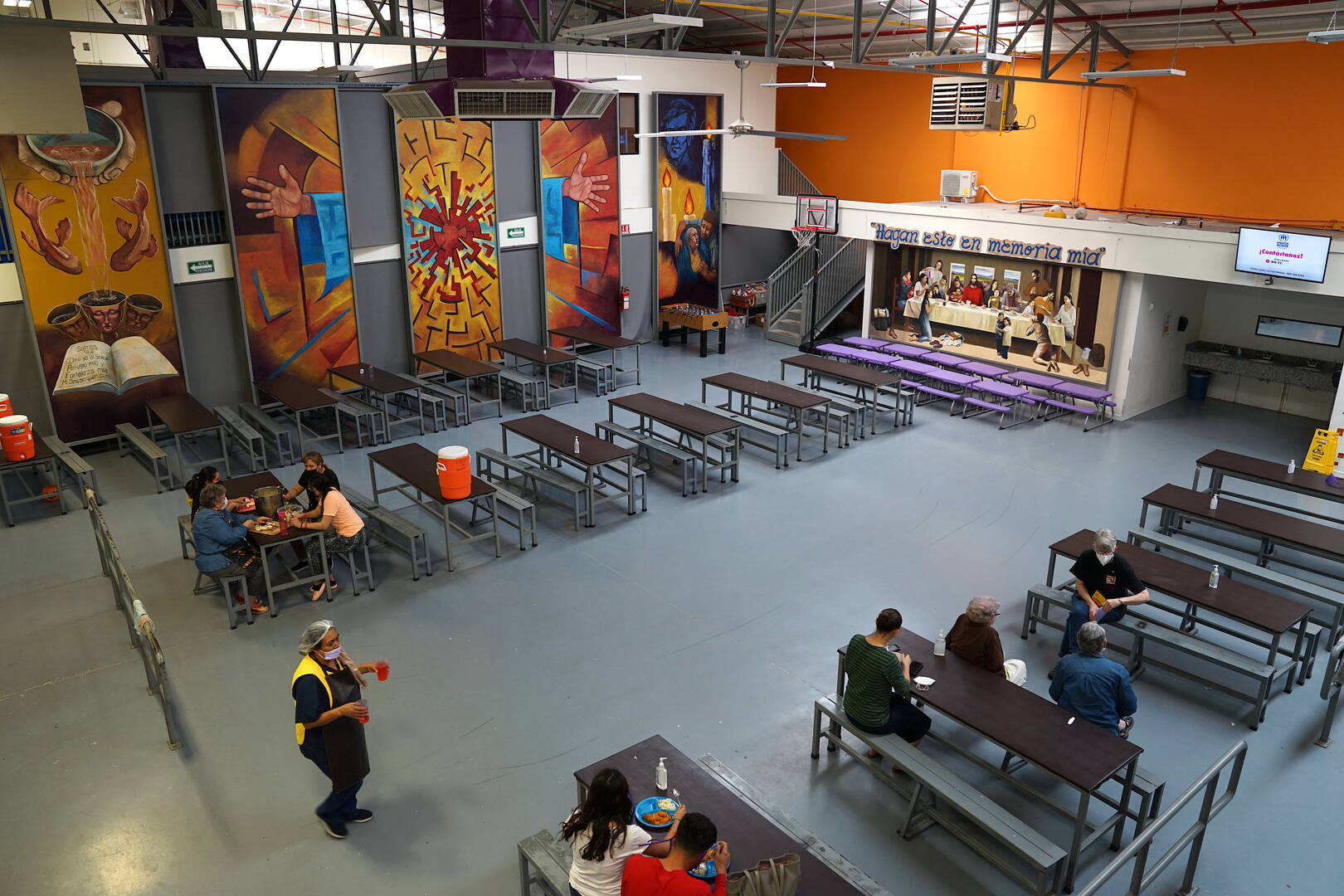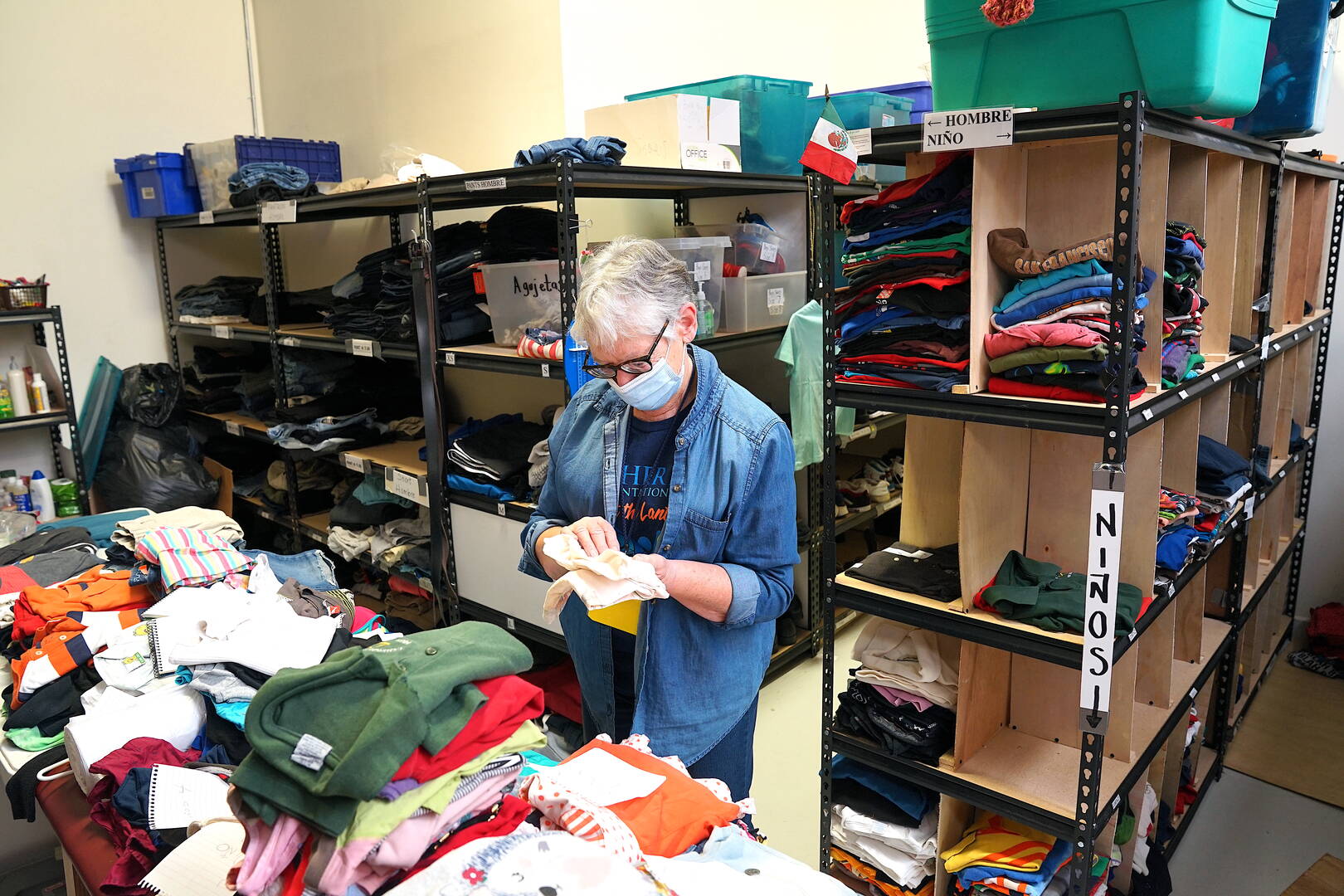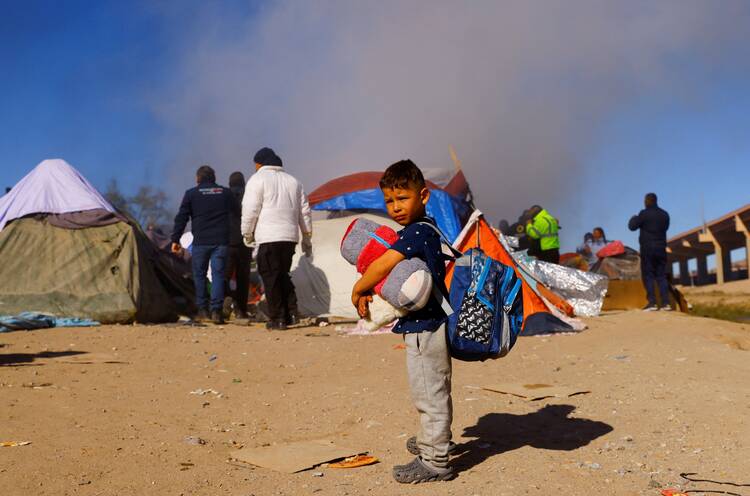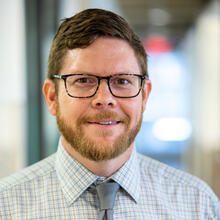María had a nice life in Vera Cruz, Mexico. She had a good job and a house. Her father did well for himself, too, harvesting sugar cane and planting beans and corn. But being successful in Mexico can come with complications. For María and her family, it meant becoming the target of organized crime.
“That’s what these people look for, to take advantage of people who have things,” María told America, speaking of such criminals. She asked not to use her last name as a safety precaution. “One day, they came in and threatened us…. So we decided to leave. My family is all over the place.”
Her family knew the threats were real. The group, which she identified only as “organized crime,” had killed a close family member. Despite being in a different state, María and the other migrants still feared what drove them to leave their homes in the first place: a criminal element that crosses state lines and that includes complex networks of drug cartels, gang members or human trafficking organizations. Apprehensive over the lingering threat, migrants leave that criminal element nameless.
María moved to another state in Mexico, but the criminal organization found her there. For the last 11 months, she has been in Nogales, Sonora—on the south side of the U.S.-Mexico border—waiting to plead her asylum case. “Being here does not mean you’ll be safe,” she said. “I’m not safe here.”
The end of Title 42 could lead to the restoration of asylum on the border. The end of the measure could allow these families to, at long last, find safe haven.
In the building where María lives now, she says she has seen people taken away and beaten. She was caught in the middle of gun fire not long ago. But for her, the most difficult part of the situation is that she is waiting to plead for asylum with her 6-year-old son.
The main obstacle to the family seeking asylum is Title 42, a health ordinance put into place by the Trump administration during the Covid-19 pandemic to summarily expel migrants back to Mexico. Since it became effective in March 2020, Title 42 has led to the expulsion of more than two million people. Last month, U.S. District Judge Emmet Sullivan struck down Title 42. It is scheduled to end on Dec 21.
The end of Title 42 could lead to the restoration of asylum on the border. The end of the measure could allow these families to, at long last, find safe haven. Still, the end of the policy has been met with resistance by some. On Dec. 14, Texas Governor Greg Abbott issued a statement that read, “With the end of Title 42 just days away” he was “calling on the Texas Attorney General’s Office to initiate an investigation into the role of NGOs in planning and facilitating the illegal transportation of illegal migrants across our borders.” On Twitter, Dylan Corbett, executive director of The Hope Border Institute, called Gov. Abbott’s statement “a vile threat to all of us on the border working to pick up the pieces of a broken immigration system, to create legal pathways for vulnerable migrants and to offer dignified welcome.”
Many migrants await the change in policy with hope. “I have faith that they will give us asylum,” María said. She is not looking for wealth or fame in America, she said, but something more ordinary. “I’m just looking for safety for my child. As a mother, I just want my child to be O.K., to be able to go to school, to become something. I’m not looking for money, but for us to have a dignified life.”
The Kino Border Initiative serves recently deported migrants and those who, like María, have become stranded on the border while making their way to the United States.
Education interrupted
It has become all too common to find parents stranded with their children along the U.S.-Mexico border, according to Joanna Williams, executive director of the Kino Border Initiative. Kino is a binational Catholic ministry that offers humanitarian assistance to migrants in Mexico and advocates for a humane and just immigration reform in the United States.
One of Kino’s key outreach locations is in Nogales, a five-minute walk south of the U.S.-Mexico border. There, workers and volunteers offer a number of services, including food, shelter for 120 people and what they call “holistic accompaniment”—including know-your-rights seminars, recreation and spiritual care. They serve recently deported migrants and those who, like María, have become stranded on the border while making their way to the United States.
The initiative serves meals to more than 200 people every day. Six years ago, workers at the initiative might see approximately five to 10 children a month. These days, though, a third of the people they serve are children accompanied by their parents.
Although living at the border has its own stressors, it can also be a place of safety for many of the children who arrive already having experienced some form of trauma or disruption in their lives. The Mexican government closed schools for 14 months as a precaution during the pandemic. But that is certainly not the only factor.
“Most of the kids already experienced an interruption in their schooling before they arrived here,” Ms. Williams said. Sometimes, she explained, when different gangs controlled different parts of a town, teachers did not feel safe coming to school.

Her office overlooks a larger dining area where volunteers serve migrants hot meals. The entire facility is immaculate. Someone began to play the guitar and sang a happy song.
“Many of them are coming from a place where their kids haven’t been to school for a couple of years,” Ms. Williams said. “Partly because of the pandemic, which I think is a shared experience nationally. Mexico was one of the countries that shut down their schools for the longest time.”
In addition, many of the children arriving at Kino have witnessed murder or rape, Ms. Williams said. Some come from families where the father was kidnapped. One child she met witnessed his father being taken away. Some families are able to pay the ransom, but others cannot.
Bernadette Eguia, one of Kino’s social workers, said there are whole communities in Mexico that are being displaced by narcotrafficking and organized crime. When they arrive at the border, most rent small apartments. Sometimes, because of high prices, multiple families will share the same space. But while they may be in a new town, they are still surrounded by drug traffickers and a government that failed to protect them in their hometowns, she said.
“They’re in a moment in which their life plans cannot proceed,” Ms. Eguia said. “They live day by day. They first secure food and where to sleep, and whatever else comes is a luxury. Where they had begun seeing education as a right, now it has become a privilege. There are few who can make it to the school, and fewer that feel welcomed.”
It is not uncommon to come across children who are depressed, she said. In Nogales, there is little space for recreation, little socialization, and the children do not trust many people, Ms. Eguia said. Those factors take a toll on their mental state.
“While there’s a sea of people here, there’s still profound loneliness. There is a powerlessness they feel. We ask the children what they want to be when they grow up, but they don’t know anymore.”
Families sat in the lobby just outside her door. Some seemed weary, but others seemed almost joyful. Some of the children played with one another while they waited to speak with an advisor or Ms. Eguia.
“While there’s a sea of people here, there’s still profound loneliness. There is a powerlessness they feel,” she said. “We ask the children what they want to be when they grow up, but they don’t know anymore.”
A family in transition cannot truly heal from that level of trauma, but Ms. Williams and Ms. Eguia seek out partnerships with local schools to try to make some kind of education possible. Many schools in the area, however, do not accept students on a temporary basis. And when they do, it often does not work out for the students themselves.
María, for example, tried putting her son into kindergarten. But his classmates bullied him after learning he is from another state. “They scratched him and took away his things,” she said. “I was afraid to put him in first grade. When he began, they bit him and hit him. He came home without his pencils and his pencil sharpener.”
A persistent threat
Laura, who is in Nogales with her husband and two children, fled the Mexican state of Michoacán. She did not get into specifics, sharing only that she was given a strong motivation to leave. On the bus ride north, she said, gangs regulated who got on.
“My children were crying as we came, asking me why,” said Laura, who also did not reveal her last name for fear of her safety. “As a parent, it’s hard to answer that question. We got here not knowing what to do next.”
Kino has helped, including with finding a place to stay. Kino partners with Save the Children to offer arts and crafts activities for children at the facility. Laura tried to send her children to school, but it did not work out.
“We don’t want the American dream or money or anything. We just want our children to be safe and to be able to go outside and not live in fear that a car will come by and take them.”
“All the schools here ask for documents that we weren’t able to bring,” she said. “The schools also don’t want to have students who are immigrants and who are leaving soon.”
Even though they are from the same country, she said, people in Nogales discriminate against them because they are from a different state. “We’re scared,” she said, sharing a story of a woman whose child was torn from her arms by criminals.
“I don’t let my children go out to the park. Life is hard here,” Laura said. “We don’t want the American dream or money or anything. We just want our children to be safe and to be able to go outside and not live in fear that a car will come by and take them.”
Like María and Laura, many families flee danger in their hometowns only to find they are still surrounded by it while waiting on the border for asylum. In María’s home state of Vera Cruz, a mass grave with 250 bodies was discovered in 2017. Laura is from Michoacán, home to a major drug cartel known for its exportation of fentanyl to the United States.
And many are arriving from Guerrero, a state in southwestern Mexico known for its agriculture and mining. In more recent years, however, corruption and organized crime have taken hold. In 2014, for example, Mexican officials covered up the kidnapping of 43 student teachers. This past October, an armed group killed 19 people in San Miguel Totolapan, including the city’s mayor.
Natidad fled Guerrero five months ago with her 4-year-old boy and 6-year-old girl. “I had to abandon my house, my business, everything,” she said, though she did not get into specifics. They feared for their lives and left in haste, leaving behind many important documents.

“We fled. We didn’t decide to come here. We didn’t think about it,” she said. “We left from one day to the next. We had hours to leave. We received death threats.”
She and her husband liked their jobs and life was good. But the problem, she said, is organized crime.
“That’s why we’re here,” Natidad said. “It’s not easy. Someone comes along and tells you to get out of your house. They’re going to keep it, even though they didn’t work for it. And you’re left with nothing.”
But Nogales has not been much better, she said.
“There is crime everywhere,” Natidad said. “We’re from a good family. We never got mixed up in anything. But that’s the problem everywhere. Once you get a job and start making money, they expect you to pay them for having a business. And if you don’t pay, well, there are consequences. That’s the way it is.”
Now her children are with her all the time. She is less worried about her daughter, who is learning on her tablet. But her son, who has a learning disability, is falling further behind. He needs a specialist, she said.
The end of Title 42 brings hope that things will change. Yet simply asking for asylum does not mean it will be granted.
Finding appropriate schooling can be especially difficult for high school students, according to Ms. Williams, because high school is not free in Nogales.
“Every grade of school a kid misses is a problem from a developmental perspective,” she said. “But I think there’s a particular sadness when it comes to high school students because many of them were people who, in their hometowns, had an idea of what they wanted to be in the future.”
But when, for various reasons, they fall out of the routine of attending high school, they often wind up never going back and joining the workforce, she said.
An uncertain future
The end of Title 42 brings hope that things will change. Yet simply asking for asylum does not mean it will be granted. According to data researchers at Syracuse University, the denial rate in asylum cases heard by an immigration judge steadily climbed from 2012 through 2020. Despite partial court shutdowns due to the Covid-19 pandemic, the denial rate reached a record high 71.6 percent in 2020.
Yet even those numbers can be misleading. In many cases, asylum seekers are denied asylum even before they reach a judge, according to Luis Guerra, a legal advocate with the Catholic Legal Immigration Network.
“Even being able to enter the system has been a problem,” he said, noting that the issue predates Title 42. Before the pandemic, U.S. Customs and Border Protection agents used a process called metering to limit the number of people who could ask for asylum at a port of entry each day. Because of metering, he said, it is possible some individuals have been waiting to petition since as far back as 2018.
“When we talk about people being denied asylum at the border, no one’s actually looking at their claims. No one is allowing them to present their case. They’re not even allowed to be processed,” Mr. Guerra said.
“We need the administration to take bold action and move away from the deterrence practices as their solution. And we have yet to see that.”
So how will things change when Title 42 ends?
“The short answer is that we don’t know,” Mr. Guerra said. “We hope that more folks will actually have their asylum cases heard. But we’re unsure on how that’s actually going to play out. We need the administration to take bold action and move away from the deterrence practices as their solution. And we have yet to see that.”
It is still possible that Title 42 will remain in place. A proposal from Sen. Thom Tillis and Krysten Sinema would offer a path to citizenship for Dreamers, undocumented immigrants who came to the United States as minors. But the proposal also includes border security concessions, including more funding for border officers and a continuation of Title 42. The Biden administration is also reportedly preparing to implement more asylum restrictions in preparation for the end of Title 42.
Even if Title 42 does end, Mr. Guerra said, it will not be enough. His hope is that there can be a partnership with humanitarian groups working on the border so that immigration can be done in a humane and dignified way. Most Americans would support that, according to a recent survey by the U.S. Immigration Policy Center. More than 73 percent of respondents said the United States should provide asylum to people fleeing persecution or violence in their home country.
Despite facing many challenges, the families that Kino serves believe things will get better eventually, Ms. Williams said.
“Many people here have probably had relatives who have been killed, or have witnessed horrific violence. They’re families first, they’re people first. And there’s this grace of hope that God gives us,” she said. “There’s a real spirit that people cherish what they have, and that’s part of what generates hope. For some, the kids’ activity room becomes a little glimpse of the kingdom of God. And that’s going to propel them forward and help them to believe that the light shines in the darkness and the darkness will not overcome it.”








